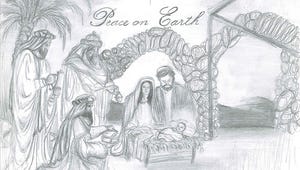Local artists spark creativity off-the-clock
It was several decades ago, but Gettysburg native Bruce Cluck still remembers the hot summers spent hopping on his bike and riding over to Gettysburg Military Park. He'd sit for hours watching a blacksmith re-enactor heat the iron, working the metal into a curved shape to make horseshoes or hammering it into hinges using 1800s-era tools.
“I would get on my bike and pedal over and watch this guy all day,” Cluck said.
Cluck eventually became a blacksmith himself, more as a way to create art than daily wares. Like so many, Cluck has had to balance his art with paying the bills.
Although his work receives more and more attention these days via word of mouth and his Facebook page, he has always had to keep his passion separate from his full-time employment by necessity.
"I was never in a position where I could afford to make that transition," Cluck said.
In a 2014 Gallup poll, Americans reported working an average of 47 hours each week, well beyond the traditional 40-hour work week.
How does the creatively inclined individual (and researchers say that’s all of us) make time for artistic goals and pursuits when it’s so much easier to flop down in front of the TV after work?
“Creativity requires activity, and this is not good news to most of us," writes author Julia Cameron, describing the push-pull of the creative person’s dilemma in her book, "The Artist’s Way." "It makes us responsible, and we tend to hate that.”
Three artists - all with jobs, families, bills and obligations - have found their own ways to conquer their resistance and consistently tap into their own inner creativity and passions.
Bruce Cluck, blacksmith
Pass by Bruce Cluck’s Carlisle Pike home on a weeknight or a rainy Sunday, and odds are good he’ll be working behind the house in the small garage he calls “the shop.”
“I’ve always had a fascination with doing things the way previous generations did them, stone tools, arrowheads, nails,” Cluck said. His work is highly functional - a wine glass holder, a flower pot or a poker for the fire and fireplace tools - but it also yields the unexpected and beautiful: colored marble that he melts into a suncatcher, or a pumpkin made of molded horseshoes.
Born and raised in Gettysburg, Cluck describes himself as “always on the edge of artistic,” enjoying drawing and painting, including Civil War miniatures.
After a stint in the military, Cluck was the deputy warden at Adams County Prison until leaving for Schindler Elevator around 2000, where he is currently work group leader.
It was at Schindler where he met fellow employee and master blacksmith Karl Orndorff, who would become his mentor.
Cluck learned through a lot of “trial and error,” and thanks to Orndorff, kicked his perfectionist tendencies, he said.
“When I would make something with Karl, I would have to go back and 'fix it,'” Cluck said. But Orndorff would always tell him, "If it looks right, don’t mess with it."
"Those little imperfections were part of the charm,” Cluck said.
As a father of three, striking a balance between job, fatherhood and his creative time can be tough. The children are always the number one priority, Cluck said, but if they want to get involved when he’s working on a piece - he jokes that they are his “forge monkeys” - they are welcome.
“I taught them early on, every piece of metal is hot unless you know otherwise.”
Stepping away from the daily routine, even if it’s with an old movie or grabbing a cup of coffee and his sketchbook, helps Cluck generate creative projects, he said. He saw "The Revenant" recently and came away with “all these different ideas.” When he can, he’ll take two or three weeks wandering in the Adirondack Mountains, to clear his mind, creatively refuel.
Seeing your own creative potential through boils down to choices and willingness, Cluck said.
“If you have it, you have a choice: You can either get up in the morning and chase it or go back to bed."
Facebook: Hammered at the Anvil Ironworks
Judy Boyle, graphic designer
For Hanover resident Judy Boyle, 3:30 a.m. comes early. By 5:45, Boyle is in her car and headed into Baltimore, where she is employed as a promotions artist with the Baltimore Sun Media Group, helping design advertising and marketing pieces.
Boyle’s situation is perhaps less common than most: She's a graphic designer by day and prolifically creative outside of it as well, doing painting, drawing, sketching, illustrating and photography, the latter of which includes a camera collection started in 1988.
“I’ve been really happy in my job because I’m doing something I enjoy doing,” Boyle admitted. She knew even back in her Hampstead, Md., high school days, she wanted to choose an area “where I could make a living.”
After 14 years of commuting, her ability to carve out creative time is down to a science.
She makes lists, she said, listens to podcasts in her car on the way to work, often photo or film-related or “How Stuff Works.” She packs an art bag with a watercolor kit and sketchbooks and tries to draw during her lunch hour.
She has also become clear about the limits of her time and energy, saying she has never had the desire to do freelance work on the side.
“I found that, in my spare time, I didn’t want to be creating work for other people; I wanted to do what I wanted to do.”
Boyle posts frequently to her Instagram account and takes part in 52-week drawing and photo challenges. If she finds herself at a loss for what to sketch, she’ll look through kids' books, or a book of dinosaur illustrations, anything to glance through that might "spark an idea,” Boyle said.
She has let go of perfectionism, and her advice to others who suffer from it is simple: Just draw something, she said, because it’s your "own way of doing it,” a person's own unique artistic expression that matters.
Even though Boyle makes her living as a professional artist, she understands what it’s like to step out of one’s artistic comfort zone. She describes the first time she attempted plein air - a French word for drawing in daylight or outdoor light - sketching out at Sachs Bridge, and people would walk up and stand behind her. Boyle persevered with some quick sketches but said she felt “a little nervous” about her creative ability.
Boyle’s family is supportive of her work and are creatives as well: Her wife, Brenda, sews and “doesn’t mind” posing for her photographs and sketches. One of Boyle’s two sons lives nearby and is planning to attend art school in New York. Even the cats are artistic, or at least artistically named - Dali and Escher, after Boyle’s favorite artists.
Website: judymboyle.com
Mike Woolf, musician
It’s pretty hard to offend Westminster musician Mike Woolf.
“If you are going to do anything artistically - even if it’s cooking a meal - you’re opening yourself up to criticism. Especially if you’re playing in a band in a bar with alcohol.”
A healthcare consultant by trade and a musician in his free hours, Woolf heads to Philly four days a week on the 6:13 train. He uses the a.m. ride to sleep and the return home to write lyrics. He’s usually home by 7 p.m. and blocks out at least half an hour to do music at the home he shares with his wife and daughter. Together with his band Twenty Dollar Prophet, Woolf books over 20 gigs a year, including the most recent Gettysburg Rocks. A veteran of “four serious bands and various other projects” prior to Prophet, Woolf has performed live for more than two decades.
“Anybody who has the guts to get up in front of the crowd and do their thing, I have respect for,” Woolf said. He has experienced drunken hecklers and outright criticism, but it's something he takes with a grain of salt.
“Sucks is a relative term," Woolf said, referencing the refrain often lobbed at bands while playing to an inebriated crowd. In some ways, someone's derision can come from what they haven't stepped out and tried themselves, "jealous that they're not the ones up there playing," he said.
Coming of age in Reisterstown, Md., Woolf “saw a million concerts - it was all I would spend my money on.” He took basic guitar lessons as a teen. “You had to rely on the older kids down the street that were more advanced to show you stuff.”
When Woolf’s first band became popular, he and his bandmates briefly toyed with the idea of leaving for Los Angeles.
“We had seen four or five of our friends go to L.A. and come back with their tail between their legs,” Woolf said. At that point, they were pretty tied to the area: One member was starting college, another starting a family.
Whether or not he’s in a band, Woolf said, he still picks up the guitar. “Sometimes it’s a struggle, a frustration to get out what’s in your head, but it’s a frustration I love.”
Woolf joked that with the home’s TV-to-people ratio (4:3) there are plenty of opportunities for distraction. He keeps his focus with small blocks of time, keeping the guitar in the living room and playing it a bit each time he walks by.
“It’s a balance,” Woolf said, “like anything else.”
He also has creative support with his bandmates, all within a 5-mile radius, which Woolf said is great for practicing “or if you need to borrow 30 bucks.”
Even with the best of intentions, there are days Woolf will try to prioritize his music, but life still gets in the way, leaving him going to bed at the end of the day feeling like something is missing.
Woolf has had to learn a lot of the things the hard way, he said. What’s one of the biggest lessons he would impart to others if he could?
“Don’t let anybody tell you you’re not worth it, and it’s a waste of time.”
Facebook: Twenty Dollar Prophet
Tips from local artists
- Don’t wait for big blocks of time. Use the small increments - 10 minutes in the morning, half an hour during lunch break - and your progress will add up.
- If you’re tired or lacking focus, set your phone alarm or an egg timer for 15 minutes. Sometimes just getting started generates enough momentum to keep you going.
- Take advantage of free (YouTube) and subscription (Lynda.com) tutorials where you can pursue your interests and learn new skills at your own pace.
- Find a mentor or like-minded folk through local galleries, arts guilds or creative co-operatives in your area. Social media sites like Facebook, Pinterest, Instagram, Flickr, Etsy, Craftsy.com and Meetup.com also offer opportunities for building community and putting your work out to a wider audience.
- Expect setbacks in your schedule - a sick kid, deadlines at work, visiting relatives - and don’t beat yourself up if you don’t log any creative time for that day or week. Pick up the rhythm again when you can.



